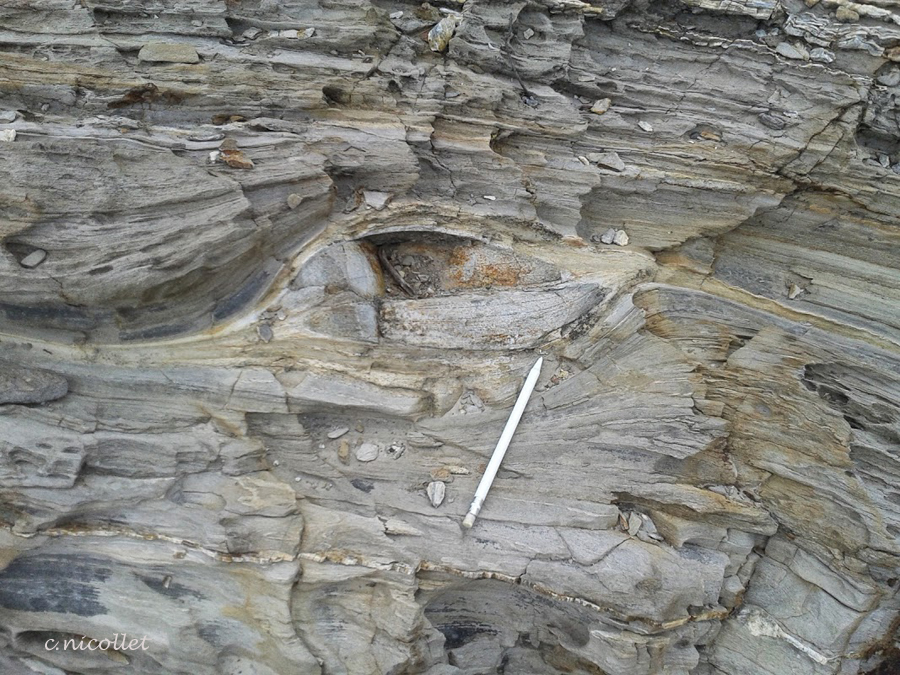
- The late shear zones of Cap Creus
The metapelites and pegmatites of Cap Creus, Spain, show 3 tectonic surfaces: 2 foliations S and a shear plane C, oriented NW-SE. Let us take a look at these shear zones.
Map of Cap Creus after J. Carreiras
It can be seen, on the map above, that the sillimanite isograde (black line) is shifted by these dextral shears. These shear zones are contemporaneous with retromorphosis.

Near Cala Culip, metapelites and pegmatites are cut by dextral shear zones
These shears are several kilometres long and on average about ten metres wide.
The shear zone that runs along Cala Fredosa (south of the lighthouse) is about ten metres wide.
We notice a plane (red dotted line) above the main shear zone and parallel to it.
This small shear is located on a fracture produced by hydraulic fracturing .
This is a (small) shear zone that has been located on a pre-existing fracture plane, generated by the hydraulic fracturing discussed previously.
Kinematic criteria
Let's go back to the centre of the shear zone of Cala Fredosa (which extends for one kilometre, on the east coast of Cala Culip)
The rotation of the vertical schistosity (S) in the vicinity of the shear zone (C) is evidence of a dextral movement of the shear zone.This is confirmed by various kinematic criteria within the shear zone, such as this asymmetric object:

In a dextral shear, the schistosity plane plunges to the left.
Structures C-C'
In the core of the shear zone, the metapelite has an undulated appearance, by the combination of two planes: the main horizontal plane is a shear plane C and a discontinuous, orange-coloured plane (marked by tiny hematite crystals), dipping to the right, is called plane C'.
C-C' structures in the shear band..
As noted in the sketch above, the planes of schistosity and shear are at an angle (the criterion of dextral or senestral sense); as the deformation gradient increases (from top to bottom in the drawing below), this angle decreases ... (see the 2 régimes of the deformation)

... when this angle tends to zero (at the bottom of the figure), a new surface appears, C' which plunges to the right.
In the case of a sinistral shear, the figure is reversed.
Dissymmetrical folds are good criteria for the sense of shear: an S-fold indicates sinistral shear while a Z-fold, like the one below, indicates dextral shear.
Z-drag fold of a dextral shear
Notice that the fold is anisopaque (= the thickness of the layers varies): the clear level is thicker at the hinge than on the sides of the fold.
... and Sheath Folds
When we can observe these folds in 3 D, we notice that their axis is often curved ...
Curved axis folds at Cala Fredosa... which implies a variable deformation (and displacement) along the fold axis. If the curvature becomes more pronounced, the result is a sheath fold with its characteristic "nose", forming a typical closed structure, on a section perpendicular to the shear sense (thick arrow on the drawing below):
Drawing from "Monts et Merveilles" by M. Mattauer
Section of the "nose" of a sheath fold, later foldedSheath folds are abundant (see another example of "nose"?) at the Cap. And below, a beautiful curvature of the axis of this almost sheath-fold
Pseudotachylite
In the heart of major shear zones, small fractures are occasionally observed, filled with a very fine, dark grey to black material: this is pseudotachylite.
Why this strange name? Since it was not possible to give it a name based on its unknown origin, it was given this name because of its resemblance to basaltic glass, tachylyte.

Microphotograph under PPL of the pseudotachylite.
Under the microscope, the black material has a brown colour; it is glass mixed with fine debris of the rock: cataclasite.This rock is formed on fault planes that have ruptured very rapidly and are associated with seismic activity. The melting is due to the high frictional heat. This rock could be appropriately renamed "frictionnite", a term that seems to be used exclusively (?) for this type of rock formed during landslides and rockfalls!
Pseudotachylites are abundant in the "impactites" of meteorite impact craters (e.g. Rochechouart, Sudbury, Canada, etc.)
See also ductile normal faults .
See also the LP-HT metamorphism at Cap Creus.
![]() Back to the PhotoGallery or the Home Page?
Back to the PhotoGallery or the Home Page?